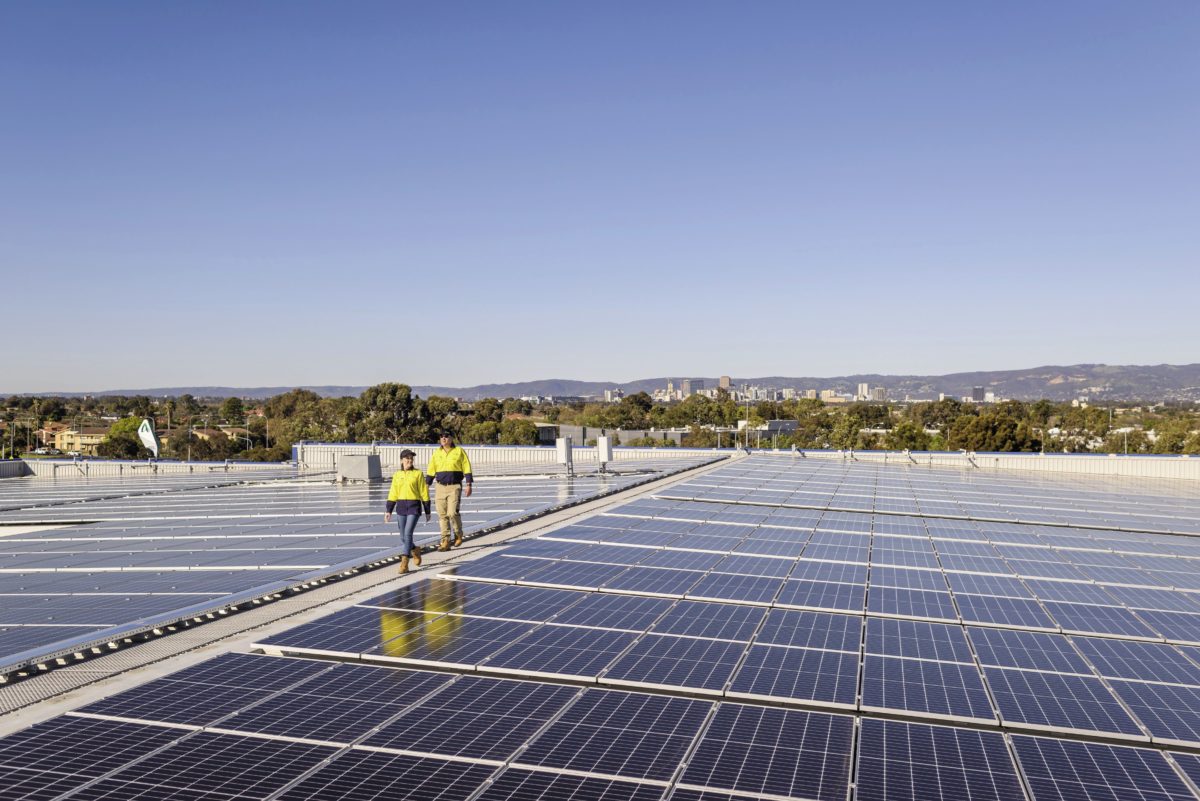Australia’s largest grid-connected microgrid is taking shape. The system is being constructed atop a vast Ikea store adjacent to Adelaide Airport, in the state of South Australia. The state has established itself at the vanguard of the country’s energy transition, sourcing just shy of 60% of its total electricity generation from clean energy in 2020.
The Adelaide Airport Ikea is being transformed into a “mini power station,” demonstrating what’s now possible in the commercial and industrial (C&I) segment. For the homeware giant, the flagship project will see Adelaide become its first store, and one of the first commercial sites globally, to be 100% powered by on-site renewables by 2025. Moreover, the company has said that the project’s success could see Ikea “transform itself into an energy provider.”
For its ongoing partner and project developer, EleXsys Energy – licensed in Australia as Planet Ark Power – the microgrid will be living proof of its claim that EleXsys technology can revolutionize the C&I space by removing its two key roadblocks. The first is the technical issue of curtailment; the second, the age-old landlord-tenant contractual and legal impasse. The system is bundled with intelligent software, with EleXsys Energy co-founder and Executive Director Richard Romanowski describing the company’s technology as being “the magic of 1+1+1=5.”
That “magic,” Romanowski says, has allowed the AUD 8 million ($5.8 million) Ikea microgrid to become not only reality, but six times the size of what could otherwise connect to South Australia’s notoriously congested grid. Ikea’s 1.2 MWp rooftop solar array has already been installed, with its 700 kW carpark and 3.36 MW/3.45 MWh CATL battery energy storage system to be energized by April next year, supplying more than the store’s entire annual electricity needs. The system will be managed by the EleXsys platform, which Romanowski claims can allow PV and battery projects to be expanded as much as tenfold.
Origin story
To explain precisely how EleXsys pulls off this trick, it’s helpful to take a few steps back to Bevan Holcombe, the main developer of the EleXsys technology, and the other half of the founding duo. After Holcombe retired as a network planner at state-owned utility Energex in 2012, he remained bothered by the voltage instability that rooftop solar was already stirring in the northeastern state of Queensland’s electricity distribution networks.
Ruminating on how clean electrons could be quickly and cheaply integrated into existing infrastructure, Holcombe arrived at conceptually miniaturizing a static synchronous compensator (STATCOM) device, digitizing it to provide reactive power and control voltage. The now finessed grid-forming device is roughly the size of two desktop computer towers and sits beside the solar inverter to keep it operating in optimal voltage bandwidth. The company says this allows it to fit multiple times the renewable electricity into one-way grids, effectively preventing curtailment of exports, while only using around 1% of the solar system’s power.
Importantly, the device sets in motion a circular system whereby it fixes voltage problems to allow more solar electricity into the grid, in turn causing frequency problems which are then managed by its batteries for a handsome sum. Today, EleXsys is this system, and voltage management is just one of a suite of services culminating in AI-driven energy trading software. This allows the Ikea microgrid to become the first behind-the-meter project to trade on Australia’s lucrative electricity spot markets, Romanowski says.
Nigel Morris, head of business development at Solar Analytics, describes EleXsys as a “bundle” leveraging every possible financial benefit of solar, storage and playing on the wholesale electricity market. “If you can orchestrate all of that, I can imagine you can make it stack up,” says Morris.
EleXsys will prove at the Adelaide Ikea precisely how big this stack can become. It is also an important demonstration of the company’s “property play,” as Romanowski puts it. This play is predicated on EeleXsys’ technical solution, but strives to fix the flaws of the C&I property system.
Investment hurdles
Like most commercial spaces, the Adelaide Ikea is rented. So, like most C&I projects, it met with the usually fatal issue of who pays for the AUD 8 million immovable system – its beneficiary or its landlord? In this case, it was neither. The microgrid is in fact owned by superannuation fund Q Super, operating through its holding Epic Energy.
“Once you deal with the curtailment issue, then you actually de-risk that investment,” says EleXsys Energy’s director of stakeholder engagement, Stephan Robertson. Since its technology can guarantee export revenue streams, he says, it’s able to transform previously rickety investment cases into clearly bankable projects, making them attractive to investors like superfunds seeking to green their portfolios. By bringing in the outside investors as owners, a new horizon for the C&I segment opens up, where a tenant’s bill savings are no longer the primary financial benefit of a rooftop solar system.
It is by introducing third-party investors to commercially rented rooftops that EleXsys plans to expand, licensing its technology via a “software as a service” model, where users pay a fee in return for a “de-risked” decarbonization project. “That’s the 1+1+1=5,” Romanowski says.
It’s no coincidence that EleXsys’ audacious approach is being proven in South Australia. Flooded with distributed energy resources, the state’s sole electricity distributor, SA Power Networks, is getting creative in its management of two-way energy flows, Morris says. “They’re very willing to do experiments at the moment.” Precisely how EleXsys’ technology interacts with networks’ mandates will undoubtedly be eagerly watched once the microgrid becomes operational next year.
This content is protected by copyright and may not be reused. If you want to cooperate with us and would like to reuse some of our content, please contact: editors@pv-magazine.com.

